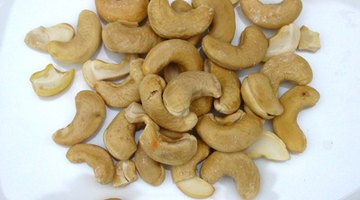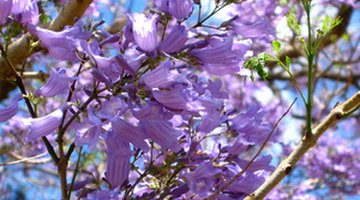A number of economically important or horticulturally ornamental trees hail from the frost-free regions of North and South America -- broadly called Tropical America. Some trees are deciduous, usually in the dry season months while others native to the consistently rainy and warm equatorial areas remain evergreen year round. Palms are not included here as they are not true trees with a cambium layer even though many are tall with treelike proportions.
Fruit Trees
Delicious juices, fresh salads and desserts are made from fruits native to the warmest parts of the Americas. Soursop (Annona muricata), cherimoya (Annona cherimola), cachiman/sugar apple (Annona squamosa), peanut butter tree (Bunchosia argentea), nance (Byrsonima crassifolia), white sapote (Casimiroa edulis), cocoplum (Chrysobalanus icaco), star apple (Chrysophyllm cainito), Suriname cherry (Eugenia uniflora), ice cream bean (Inga jinicuil), Barbados cherry (Malpighia glabra), mammey apple (Mammea americana), avocado (Persea americana), sapodilla (Manilkara zapota), Brazilian grape (Myrciaria cauliflora), mammee sapota (Pouteria sapota), guava (Psidium guajava) and chocolate tree (Theobroma cacao) all produce fruits or pulp that is edible.
Nut Trees

A few notable edible nut trees hail from Tropical America. Especially noteworthy are cashew (Anacardium occidentale) and Brazil nut (Bertholettia excelsa). Allspice (Pimenta dioica) seeds are pulverised to make spice.
Ornamental Flowering Trees

The primary ornamental feature of these trees, even though they may also provide welcome summer shade, is their seasonal and vibrant flower displays. Sweet acacia (Acacia farnesiana), cabbage bark (Andira inermis), annatto (Bixa orellana), jigger-wood (Bravaisia integerrima), Panama flame (Brownea macrophylla), angel's trumpet (Brugmansia spp.), verawood (Bulnesia arborea), pink tassel flower (Calliandra surinamensis), silk floss tree (Chorisia speciosa), Brazilian rose (Cochlospermum vitifolium), white manjack (Cordia dentata), Geiger tree (Cordia sebestena), lignum vitae (Guaiacum sanctum), membrillo (Gustavia superba), jacaranda (Jacaranda mimosifolia), golden chain tree (Lophanthera lactescens), tree petrea (Petrea arborea), cardinal tree (Phyllocarpus septentrionalis), shaving brush tree (Pseudobombax ellipticum), fern tree (Schizolobium parahyba), shower tree (Senna spectabilis), trumpet tree (Tabebuia spp.), pride of Bolivia (Tipuana tipu) and long-john (Triplaris cimingiana) are prized in tropical garden designs.
- The primary ornamental feature of these trees, even though they may also provide welcome summer shade, is their seasonal and vibrant flower displays.
- pride of Bolivia (Tipuana tipu) and long-john (Triplaris cimingiana) are prized in tropical garden designs.
Shade Trees
Well-branched trees that are best known for their attractive foliage or broadcasting of shade native to Tropical America are black olive (Bucida buceras), gumbo-limbo (Bursera simaruba), sea grape (Coccoloba uvifera), sandbox tree (Hura crepitans), monkey pot (Lecythis zabucajo), wild tamarind (Leucaena leucocephala), sabicu (Lysiloma sabicu), maga (Montezuma speciosissima), capulin (Muntingia calabura), Guiana chestnut/money tree (Pachira aquatica), candle tree (Parmentiera cerifera), bella-sombra (Phytolacca dioica), cojoba (Pithecellobium arboreum), guanacaste (Pogonopus speciosus), rain tree (Samanea saman), soapberry (Sapindus saponaria) and Montezuma cypress (Taxodium mucronatum).
Economic Trees
Certain trees species are prized for their heart and sapwood for indoor and outdoor construction, boat building, box making, and ornamental furniture or carvings. Tropical American tree species are degame (Calycophyllum candidissimum), Spanish oak (Catalpa longissima), quipo (Cavanillesia platanifolia), yagrumo/trumpet tree (Cecropia peltata), West Indian cedar (Cedrela odorata), ziricote (Cordia dodecandra), cannonball tree (Couroupita guianensis), earpod tree (Enterlobium cyclocarpum), quick-stick (Gliricidia sepium), lignum vitae (Guaiacum officinale), logwood (Haematoxylum campechianum), West Indian locust (Hymenaea courbaril), torchwood (Ixota pavetta), balsam of Tolu (Myroxylon balsamum), balsawood (Ochroma pyramidale), quira (Platymiscium pinnatum), biriba (Rollinia mucosa), mastic (Sideroxylon foetidissimum) and mahogany (Swietenia mahogani). Latex sap was tapped from Panama rubber tree (Castilla elastica), pitch apple (Clusia rosea) and para rubber tree (Hevea brasiliensis).
